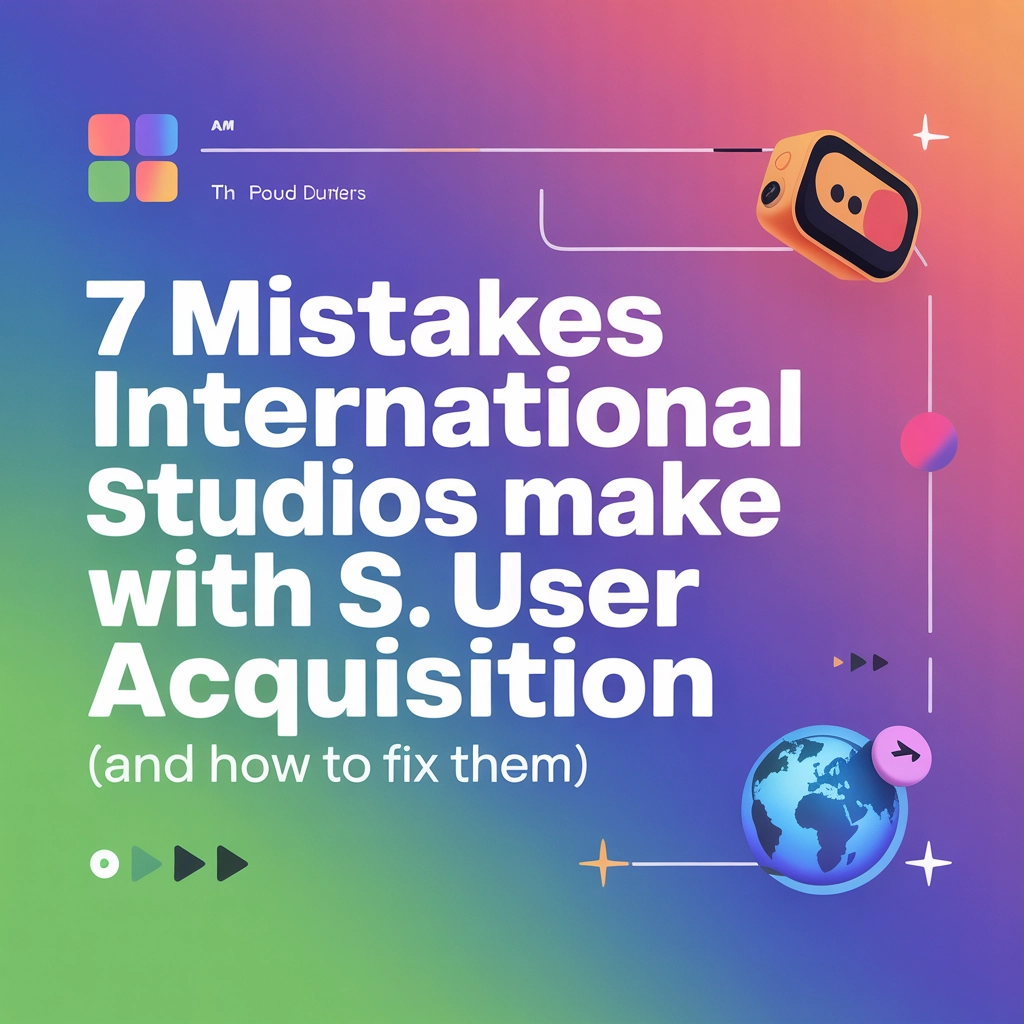7 Mistakes International Studios Make with U.S. User Acquisition (and How to Fix Them)

Breaking into the U.S. mobile gaming market isn't just about translating your game and throwing some ad dollars at Facebook. Trust me, plenty of international studios have learned this the hard way. The American gaming landscape has its own quirks, preferences, and pitfalls that can make or break your user acquisition efforts.
After working with studios from Asia, Europe, and beyond, I've seen the same mistakes pop up again and again. The good news? They're all fixable once you know what to look for.
1. Treating Creative Content Like a Direct Translation
Here's the thing: what works in Japan, Korea, or Germany might fall completely flat with American audiences. I've seen studios take their highest-performing creative assets from home markets and simply swap out the text for English. The results? Crickets.
The Problem: American mobile gamers have different visual preferences, humor styles, and gaming expectations. A cute anime-style character that dominates in Asia might not resonate with a broader U.S. demographic. Similarly, European minimalist design aesthetics might not grab attention in the noisy U.S. advertising landscape.
The Fix: Create region-specific creative assets from scratch. Test different art styles, color palettes, and messaging approaches. Start with 5-10 completely different creative concepts rather than variations of your existing content. Run small-budget tests to see what resonates before scaling up.

2. Using Home Market KPIs Without U.S. Market Adjustments
This one trips up so many studios. You've got your cost-per-install (CPI) targets and lifetime value (LTV) expectations based on your home market performance. But here's the reality check: U.S. user behavior, spending patterns, and engagement metrics can be drastically different.
The Problem: U.S. users might have higher CPIs due to increased competition, but they could also have higher spending potential. Alternatively, they might engage differently with your game mechanics, affecting retention and monetization patterns.
The Fix: Set up separate KPI frameworks for the U.S. market. Start with industry benchmarks rather than your home market numbers. Plan for a 3-6 month learning period where you're optimizing based on actual U.S. user data, not assumptions from other markets.
3. Surface-Level Localization
"We translated everything to English" doesn't equal proper localization. Real localization goes way deeper than language: it's about cultural context, payment preferences, customer service expectations, and even gameplay balancing.
The Problem: American gamers have specific expectations around customer support response times, payment methods (hello, PayPal and Apple Pay), and even game difficulty curves. Your game might be perfectly balanced for Asian grinding culture but feel too slow for impatient American players.
The Fix: Partner with local user research firms to understand American gaming preferences. Adjust game progression, offer region-appropriate payment methods, and set up customer service that operates in American time zones with native English speakers who understand local gaming culture.

4. Ignoring U.S. Privacy Regulations and iOS 14.5+ Impact
The iOS 14.5 update and various U.S. privacy laws have completely changed the user acquisition game. International studios often underestimate how different privacy expectations are in America compared to other regions.
The Problem: You might be used to more permissive data collection practices in your home market. In the U.S., you're dealing with stricter opt-in rates for tracking, CCPA compliance requirements, and users who are more privacy-conscious than ever.
The Fix: Build your attribution and measurement strategy around limited data availability. Invest heavily in first-party data collection, implement proper CCPA compliance measures, and diversify your measurement approaches beyond just traditional attribution models. Consider incrementality testing and cohort analysis as alternatives to user-level tracking.
5. Wrong Platform Prioritization
Not all markets are created equal when it comes to iOS vs. Android performance. Some international studios make the mistake of applying their home market platform preferences to the U.S. without testing.
The Problem: Maybe Android dominates in your home market, so you allocate 70% of your budget there. But U.S. iOS users might have significantly higher LTVs for your game type, making them more valuable despite potentially higher acquisition costs.
The Fix: Start with a 50/50 budget split between iOS and Android for your initial testing phase. Let the data guide your platform prioritization rather than assumptions from other markets. Also, don't overlook emerging platforms: sometimes international studios miss opportunities on platforms like TikTok ads that are particularly effective with American audiences.

6. Ineffective Influencer and Partnership Strategies
Influencer marketing in the U.S. operates differently than in many international markets. The types of content that work, the platforms that matter, and the partnership structures that succeed can vary dramatically.
The Problem: You might partner with influencers who have massive followings but poor engagement with American audiences, or focus on platforms that aren't relevant to U.S. mobile gamers. Some studios also struggle with influencer contract terms that don't account for U.S. advertising disclosure requirements.
The Fix: Work with influencer marketing agencies that specialize in the U.S. gaming market. Prioritize engagement rates and audience demographics over follower counts. Make sure all partnerships comply with FTC disclosure requirements: American audiences and regulators take this seriously.
7. Missing Seasonal and Cultural Marketing Opportunities
The U.S. has a unique calendar of spending seasons and cultural moments that international studios often miss or misunderstand. Black Friday, back-to-school season, Super Bowl Sunday: these are massive opportunities if you plan for them correctly.
The Problem: You're launching campaigns based on your home country's seasonal patterns or completely missing major American spending periods. Or worse, you're trying to capitalize on American holidays without understanding the cultural context, leading to tone-deaf marketing.
The Fix: Create a U.S.-specific marketing calendar that accounts for major shopping seasons, sporting events, and cultural moments. Plan campaigns 2-3 months in advance for major periods like Black Friday/Cyber Monday. When in doubt, partner with American marketing agencies who understand the cultural nuances.

Getting Your U.S. Strategy Right
Here's the bottom line: success in the U.S. mobile gaming market isn't about applying your existing strategy with minor tweaks. It requires a fundamental understanding of American gaming culture, advertising landscape, and user behavior patterns.
The studios that succeed don't just translate their games: they transform their entire approach for the American market. They invest in local partnerships, adapt their monetization strategies, and most importantly, they're patient enough to learn from their initial mistakes rather than immediately scaling unsuccessful approaches.
Start small, test everything, and be prepared to challenge assumptions from your home market. The U.S. mobile gaming market is massive and profitable, but it rewards studios that take the time to understand its unique characteristics.
Remember, every mistake on this list is fixable with the right approach and mindset. The key is recognizing these pitfalls early and course-correcting before they eat up your entire marketing budget.
Ready to crack the U.S. market the right way? The opportunities are massive for studios willing to do the homework and adapt their strategies accordingly.






